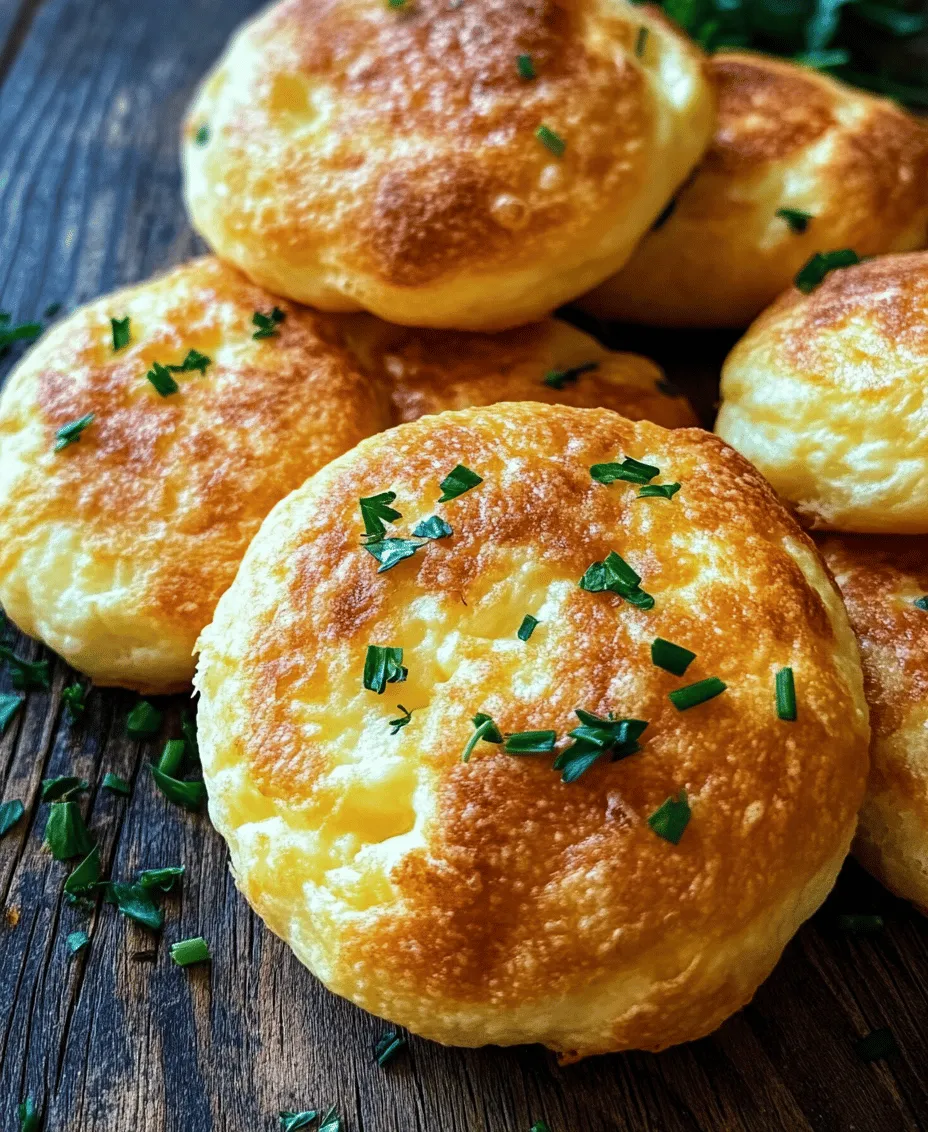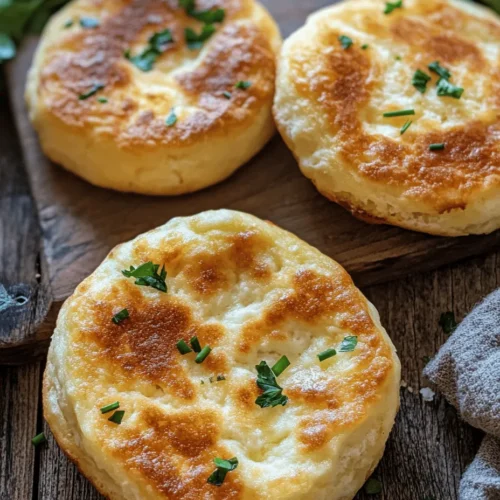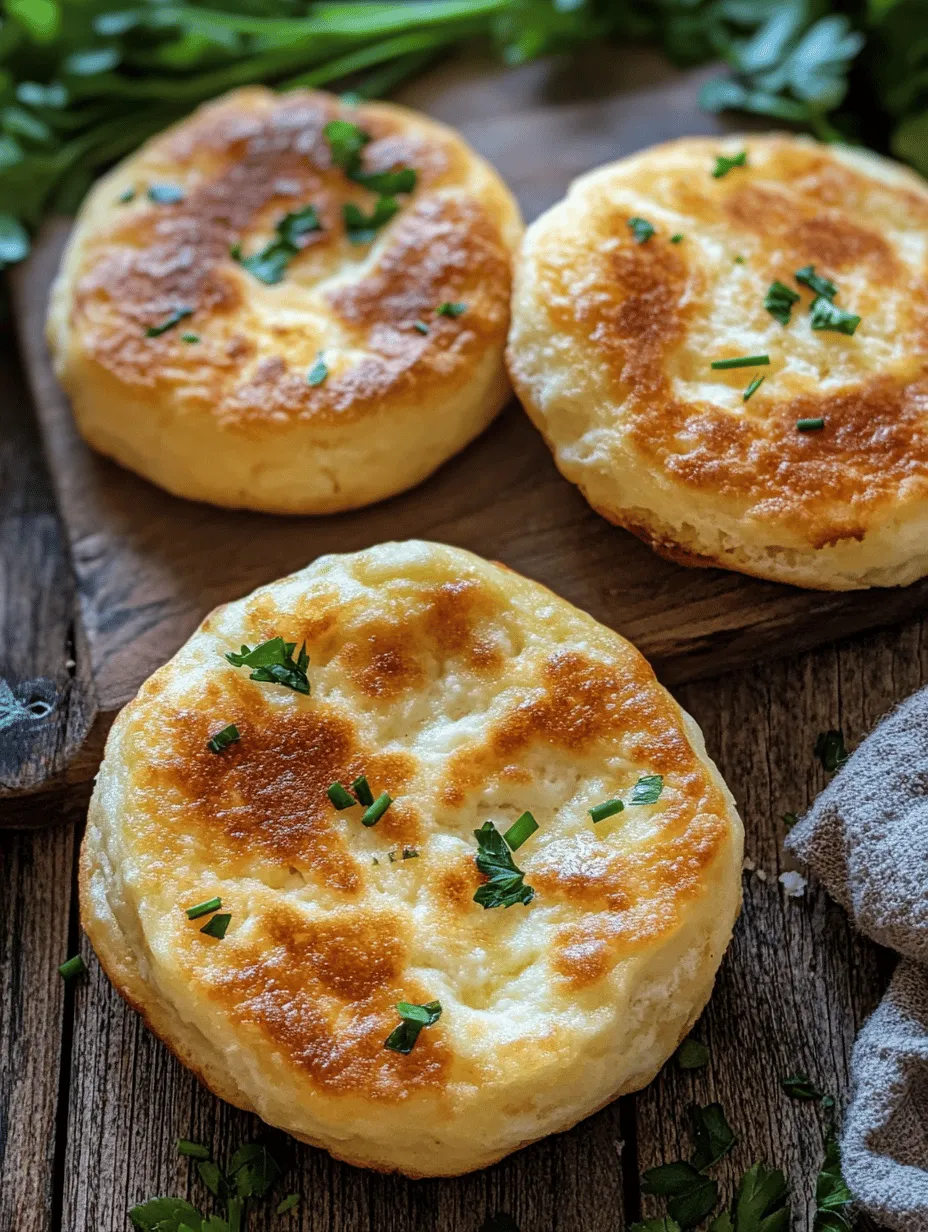Introduction to Light and Fluffy Cottage Cheese Cloud Bread
In the ever-evolving landscape of healthy eating, discovering alternatives to traditional bread can be a transformative experience. For those navigating the complexities of low-carb diets, gluten-free lifestyles, or simply seeking nutritious options, cloud bread emerges as a delightful solution. Among the various iterations of this airy creation, the Light and Fluffy Cottage Cheese Cloud Bread stands out for its unique texture and nutritional benefits. This article invites you to explore the enchanting world of this recipe, detailing its ingredients, preparation steps, and the myriad ways it can enhance your meals.
Cloud bread has taken the health-conscious culinary scene by storm, and for good reason. This innovative bread substitute is not only low in carbohydrates but also packed with protein, making it an excellent choice for those looking to maintain or lose weight without sacrificing flavor. The incorporation of cottage cheese not only adds a delightful creaminess to the bread but also boosts its protein content, setting it apart from other bread alternatives. Whether you are following a ketogenic diet, managing gluten sensitivity, or simply looking to incorporate more wholesome ingredients into your diet, this cloud bread recipe is bound to become a staple in your kitchen.
Understanding Cloud Bread and Its Popularity
The Origins of Cloud Bread
Cloud bread is a culinary invention that gained traction in the early 2010s, particularly among those embracing low-carb diets like the ketogenic and paleo lifestyles. It was originally popularized as a way to create a bread-like texture without the carbohydrates associated with traditional flour-based bread. The recipe typically consists of just a few simple ingredients—eggs, cream cheese, or cottage cheese—that are whipped together to form a light and airy dough.
The appeal of cloud bread lies not only in its low-carb nature but also in its versatile use. It can be enjoyed as a sandwich base, a wrap for deli meats, or even as a breakfast option topped with avocado or nut butter. As health-conscious eating trends continue to rise, cloud bread has firmly established itself as a go-to option for those seeking to enjoy the comfort of bread without compromising their dietary goals.
Nutritional Benefits That Appeal to Health-Conscious Individuals
The nutritional profile of cloud bread, particularly when made with cottage cheese, is truly impressive. With minimal carbohydrates, this bread alternative allows for guilt-free indulgence while still providing essential nutrients. The protein content is significantly higher than that of traditional bread, making it an ideal choice for anyone looking to increase their protein intake, including athletes and fitness enthusiasts. Furthermore, the presence of cottage cheese adds valuable calcium and vitamin B12, promoting bone health and energy production.
The Appeal of Cottage Cheese in Recipes
Overview of Cottage Cheese as a Versatile Ingredient
Cottage cheese is a remarkably versatile ingredient that can be seamlessly integrated into a variety of recipes, from savory to sweet. Its mild flavor and creamy texture make it an excellent addition to dishes ranging from salads and dips to pancakes and desserts. When it comes to cloud bread, cottage cheese not only lends a unique texture but also enhances the bread’s nutritional profile.
Nutritional Profile: Protein, Calcium, and Low in Carbs
One of the standout features of cottage cheese is its impressive nutritional composition. A typical serving (1 cup) contains approximately 25 grams of protein, making it a powerhouse for muscle repair and growth. Additionally, it is low in carbohydrates—typically around 6 grams per serving—which aligns perfectly with low-carb dietary plans. Cottage cheese is also rich in calcium, which is essential for maintaining strong bones and teeth. Moreover, it contains various vitamins and minerals, including phosphorus, selenium, and riboflavin. These qualities make it a fantastic ingredient for those who prioritize health and nutrition.
Ingredients Breakdown for Cottage Cheese Cloud Bread
Cottage Cheese: The Star Ingredient
The heart of this cloud bread recipe is undoubtedly cottage cheese. When selecting cottage cheese, you may encounter two types: large curd and small curd. Both varieties will work for this recipe, but they can yield slightly different textures. Large curd cottage cheese may produce a chunkier bread, while small curd will give a smoother consistency.
Incorporating cottage cheese into your diet can be beneficial for a variety of reasons. Its high protein content supports muscle health and satiety, making it an excellent choice for snacks or meals. Additionally, it is easy to digest, making it suitable for individuals with lactose intolerance, as many brands offer low-lactose options.
Eggs: The Binding Agent
Eggs play a critical role in this recipe, serving as the binding agent that holds the bread together. The recipe calls for both egg yolks and egg whites, each contributing unique properties to the final product. The yolks add richness and moisture, while the whipped egg whites provide the light and airy texture that cloud bread is known for.
From a nutritional standpoint, eggs are a fantastic source of complete protein, containing all nine essential amino acids. They are also rich in vitamins, including B vitamins, vitamin D, and choline, which supports brain health. This makes eggs not only a key ingredient for structure in cloud bread but also a powerhouse of nutrition.
Almond Flour vs. Coconut Flour
When it comes to the flour component of cloud bread, almond flour and coconut flour are popular gluten-free options. Each type of flour has its unique properties and benefits. Almond flour, made from finely ground almonds, is lower in carbohydrates and higher in healthy fats compared to traditional wheat flour. It also adds a pleasant nuttiness to baked goods.
On the other hand, coconut flour is made from dried coconut meat and is extremely absorbent, meaning you will need to adjust the liquid ratios in recipes. While both flours are suitable for gluten-free baking, almond flour is often favored for its texture and flavor profile in cloud bread recipes.
Herbs and Seasonings: Elevating the Flavor
To enhance the flavor of your Light and Fluffy Cottage Cheese Cloud Bread, consider incorporating herbs and seasonings. Optional ingredients such as garlic powder, onion powder, or fresh herbs like chives or basil can elevate the taste significantly. These enhancements will provide a savory twist, allowing you to customize your cloud bread to suit your palate.
Moreover, flavor variations can be achieved by experimenting with different spices or adding a touch of cheese or nutritional yeast for a cheesy flavor. The versatility of cloud bread means you can create a version that perfectly complements whatever ingredients you choose to pair it with.
Step-by-Step Instructions for Making Cloud Bread
Prepping Your Kitchen for Cloud Bread
Before diving into the preparation of your Light and Fluffy Cottage Cheese Cloud Bread, it’s essential to set up your kitchen for success. Gather the necessary kitchen tools and equipment, which include:
– Mixing bowls (one for wet ingredients and one for dry)
– A whisk or electric mixer for whipping egg whites
– A spatula for folding ingredients
– Baking parchment paper or a non-stick baking mat
– A baking sheet
Preheating your oven is also a crucial step in the process. Set it to 300°F (150°C) to ensure that the bread rises properly and cooks evenly.
Blending the Ingredients
Once your kitchen is ready, it’s time to blend the ingredients. Start by combining the cottage cheese and egg yolks in a mixing bowl. Using a whisk or a hand mixer, blend the mixture until it becomes smooth and creamy, ensuring there are no lumps. This step is vital for achieving the desired texture of your cloud bread.
After your cottage cheese and egg yolk mixture is well-blended, it’s time to move on to the egg whites. In a separate bowl, whip the egg whites until stiff peaks form. This process requires a bit of elbow grease if you’re doing it manually, but an electric mixer can make this step much easier. The goal is to achieve a light and airy consistency that will provide the cloud-like texture of the bread.
Whipping Egg Whites to Perfection
Whipping egg whites correctly is crucial for achieving the signature fluffiness of cloud bread. Start by ensuring that your mixing bowl and whisk are completely clean and dry, as any grease or moisture can prevent the egg whites from whipping properly. Begin whipping the egg whites on medium speed, gradually increasing to high speed until you see soft peaks form. This should take about 2-3 minutes.
Once you’ve reached soft peaks, continue whipping until the egg whites form stiff peaks, which means they will hold their shape when you lift the whisk out of the bowl. Be cautious not to over-whip, as this can lead to a grainy texture. Once your egg whites are whipped to perfection, gently fold them into the cottage cheese mixture, taking care not to deflate the egg whites. This folding technique is what creates the light and fluffy texture that cloud bread is known for.
Now that you have completed these initial steps, you are well on your way to creating a delightful Light and Fluffy Cottage Cheese Cloud Bread that is sure to impress. Stay tuned for the next section, where we will outline the baking process and explore how to enjoy this versatile bread in various ways.

The Science Behind Whipping Egg Whites and Achieving Stiff Peaks
Whipping egg whites to achieve stiff peaks is a crucial step in making light and fluffy cottage cheese cloud bread. The process involves incorporating air into the egg whites, which creates a foam that provides structure and volume to the bread. When egg whites are whipped, the proteins unfold and form a network that traps air bubbles, leading to the desired airy texture.
Achieving stiff peaks means that when you lift the whisk out of the whipped egg whites, the peaks stand upright without drooping. This step is essential for ensuring that your cloud bread rises properly while baking, giving it that signature light and fluffy texture.
Common Mistakes to Avoid When Whipping Egg Whites
While whipping egg whites may seem straightforward, there are common pitfalls to watch out for:
1. Greasy Bowls or Utensils: Ensure that your mixing bowl and whisk are completely clean and free from any grease. Even a small amount of fat can prevent the egg whites from whipping up to their full potential.
2. Fresh Egg Whites: Using older eggs can result in poorer volume. Always opt for fresh eggs, as the proteins in fresher whites have better stability.
3. Over or Under Whipping: Whisking for too long can lead to a dry, grainy texture, while under-whipped egg whites will not hold their shape. It’s best to whip the egg whites until they achieve soft peaks before gradually adding any sugar, then continue until stiff peaks form.
4. Humidity: High humidity can affect the whipping process. If possible, whip egg whites in a dry environment to achieve the best results.
Folding Techniques: Combining Mixtures Without Deflating
Once the egg whites are whipped, the next step is to fold them gently into the cottage cheese mixture. This technique is crucial for maintaining the volume you’ve created.
Importance of Folding in Egg Whites Gently
Folding is a technique that involves incorporating one mixture into another without deflating the air bubbles. This is particularly important in cloud bread, as deflating the whipped egg whites will lead to a dense final product.
To fold properly, use a rubber spatula to scoop under the mixture and lift it over the top. Rotate the bowl as you fold, ensuring that the mixture is evenly combined without overworking it. This technique helps maintain the lightness and fluffiness of the bread.
Visual Cues for Knowing When the Mixture is Ready
When folding, watch for visual cues to indicate that your mixture is ready:
– The batter should appear uniform in color, without any streaks of white or yellow.
– You should still see some air bubbles in the mixture, which indicates that the whipped egg whites are intact.
– The mixture should flow smoothly from the spatula but still hold some structure.
Shaping and Baking the Cloud Bread
Now that your mixture is ready, it’s time to shape and bake the cloud bread.
Tips for Shaping the Cloud Bread Rounds
When shaping your cloud bread, consider the following tips:
– Use Parchment Paper: Line your baking sheet with parchment paper to prevent sticking and make cleanup easier.
– Scoop Evenly: Use a large spoon or ice cream scoop to portion out the mixture evenly. This ensures that all pieces will cook at the same rate.
– Shape Gently: When forming the rounds, use the back of the spoon to smooth the tops, but avoid pressing down too firmly, which can deflate the batter.
Baking Time and Temperature for Best Results
Preheat your oven to 300°F (150°C). Bake the cloud bread for about 25-30 minutes, or until the tops are golden and the bread feels firm to the touch. Avoid opening the oven door during baking, as this can cause the bread to collapse. Once baked, turn off the oven and leave the cloud bread inside for an additional 5-10 minutes to help them set properly.
Cooling and Serving Suggestions
After baking, it’s essential to cool your cloud bread correctly to maintain its texture.
Best Practices for Cooling Cloud Bread
Remove the cloud bread from the oven and let it cool on the baking sheet for about 10 minutes. Then, carefully transfer the rounds to a wire rack to cool completely. Cooling on a wire rack prevents moisture from building up underneath, which can make the bread soggy.
Serving Ideas: Toppings, Sandwiches, or as a Snack
Cloud bread is incredibly versatile and can be enjoyed in various ways:
– Toppings: Spread cream cheese or avocado on top for a quick snack, or layer with smoked salmon and capers for a delicious appetizer.
– Sandwiches: Use cloud bread as a gluten-free alternative for sandwiches. Fill with turkey, lettuce, and tomato for a satisfying lunch.
– Snacks: Enjoy plain or with your favorite dips like hummus or salsa for a healthy snack option.
Nutritional Benefits of Cottage Cheese Cloud Bread
Cottage cheese cloud bread is not only light and fluffy but also packed with nutritional benefits that make it a fantastic addition to your diet.
Low-Carb Living: A Healthy Alternative
For those watching their carb intake, cloud bread is a game-changer. Traditional bread can be high in carbohydrates and calories, while cloud bread offers a low-carb alternative that allows you to enjoy your favorite meals without the guilt.
– Carb Comparison: A single slice of traditional bread can contain around 15-20 grams of carbohydrates, while cloud bread has only about 1-2 grams per slice, making it ideal for those following a keto or low-carb diet.
High Protein Content: Fueling Your Day
Cottage cheese is a rich source of protein, and incorporating it into cloud bread boosts its nutritional profile significantly.
– Muscle Recovery and Satiety: The high protein content helps with muscle recovery post-exercise and keeps you feeling full longer, making it an excellent choice for athletes and active individuals.
Gluten-Free and Dairy-Friendly
In today’s dietary landscape, gluten-free options are increasingly important, and cloud bread fits the bill perfectly.
– Significance of Gluten-Free Options: Many people are opting for gluten-free diets due to sensitivities or health reasons. Cloud bread allows these individuals to enjoy a bread-like experience without the gluten.
– Lactose-Intolerant Friendly Adaptations: For those who are lactose intolerant, using lactose-free cottage cheese can make this recipe accessible without sacrificing taste.
Creative Ways to Enjoy Cottage Cheese Cloud Bread
The versatility of cottage cheese cloud bread extends beyond traditional use, making it a fantastic addition to any meal.
Versatile Uses in Meals
Cloud bread can be integrated into various meals throughout the day:
– Breakfast: Toast cloud bread and serve it with scrambled eggs and avocado for a nutritious breakfast option.
– Lunch: Use it as a base for a hearty sandwich, layering it with your favorite meats and greens.
– Dinner: Pair cloud bread with a protein-rich main course or serve it alongside a fresh salad.
Pairing Cloud Bread with Various Dishes
To enhance your meal, consider pairing cloud bread with complementary side dishes and beverages:
– Side Dishes: Cloud bread pairs well with soups, stews, and salads, adding a satisfying element to your meal.
– Beverages: Enjoy a refreshing iced tea or a light white wine with your cloud bread creations for a delightful dining experience.
Conclusion: Embracing the Light and Fluffy Cottage Cheese Cloud Bread
In conclusion, the Light and Fluffy Cottage Cheese Cloud Bread is a delightful and nutritious alternative to traditional bread. With its low-carb, high-protein content, this recipe is perfect for anyone looking to enhance their diet without sacrificing flavor or texture. Whether you’re a seasoned chef or a kitchen novice, this simple yet satisfying recipe deserves a place in your culinary repertoire. So, go ahead, embrace the lightness and versatility of cloud bread, and embark on a healthier journey with each delicious bite. Enjoy experimenting with toppings and meal pairings, and let this cloud bread elevate your meals to new heights!


